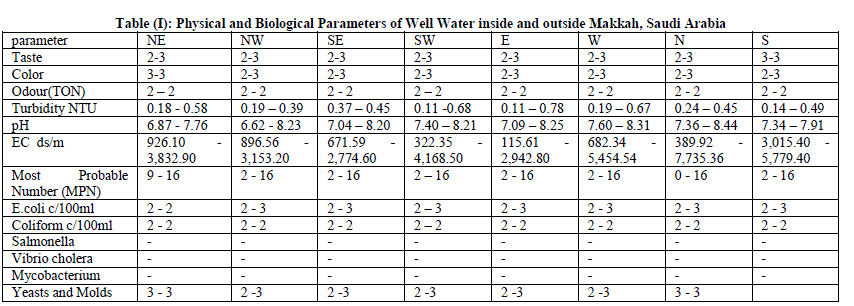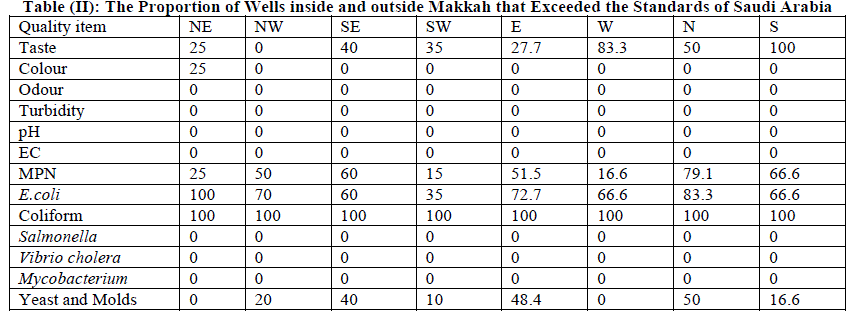ISSN ONLINE(2319-8753)PRINT(2347-6710)
ISSN ONLINE(2319-8753)PRINT(2347-6710)
Anas S Dablol1, Saleh AlGarni2, Hussain AlMehdar2, Khaled M.Ghanem3, Mohammed A Alawad1
|
| Related article at Pubmed, Scholar Google |
Visit for more related articles at International Journal of Innovative Research in Science, Engineering and Technology
well water is essential source of water in Makkah which is used for different purposes. This study was carried out to assess physical and biological characteristics of well water inside and outside Holly Makkah. Water samples were collected from all wells and examined according to Saudi Arabia standard (407/1989). The results were compared to Saudi Arabia Guidelines. Coliforms were detected in all wells, while E.coli and fungi were found in the majority of wells. Taste and MPN were exceeded the standards of Saudi Arabia in a considerable number of wells. Improvement of water treatment process is extremely needed.
Keywords |
| Physical, Biological, Coliforms, E. coli, Ground water, Makkah |
INTRODUCTION |
| There are main sources of water namely rain, surface and ground water. These sources can be exposed to contamination naturally or due to human activities [1]. Wholesome water is important for human consumption. It is necessary to ensure that drinking water should be free from pathogens. Therefore high-quality water supply is required for drinking, while the quality of water for other domestic uses can be quite variable [2]. Accessibility of safe water is important globally particularly in developing countries, however a WHO reported that about 780 million people in the world do not have access to adequate water supply [3]. In many countries ground water is considered the main source of drinking water. Due to poverty and lack of technology in developing countries to construct adequate wells, in addition to overcrowding, poor hygiene and sanitation, these wells may be contaminated by pathogenic organisms making them a potential source of health hazard [4]. Ground water (i.e. well water) is important source of water for different purposes in many areas throughout Saudi Arabia compared to marine surface water which need high sophisticated technology to be treated. The contamination of wells can be due to improper construction of wells, refuse dumping sites and various human activities around the wells. Water generally from these wells is not safe for drinking except some form of treatment is carried out [5]. Microbial contamination is considered as a health problem of well water in different areas. In a study conducted in Khamis Mushait Governorate, southwestern Saudi Arabia, it has been found that water derived from traditional sources (wells) showed increases in most of the investigated bacteriological parameters, followed by the surface water as compared to bottled or desalinated water. This may be attributed that well and surface water are exposed to biological contamination [2]. So far this study is to assess physical and biological quality of well water inside and outside Makkah. |
II. MATERIALS AND METHODS |
| A-Study area: the study was conducted in Makkahthe religious capital, Saudi Arabia. It is arid area where provision of water is a major problem however the need for water is increasing because it, usually, hosted Muslims from different destinations around the world. Majority of residents and guesses depend on well water inside and around Makkah for different purposes. Inside Makkah area was divided into North East (NE), North West (NW), South East (SE), and South West (SW), while the area outside Makkah was divided into East (E), North (N), West (W) and South (S). All wells in these sections were numbered in order to select wells to take water samples from. B-Sampling: water samples were collected from wells inside Makkah (49 wells) and from wells outside Makkah (69 wells) to investigate physical and biological parameters. These samples were collected according to Saudi Arabia standard (407/1989) and Gulf standard (111/1989). |
| C-Measured parameters |
| 1. Taste, colour and odour were examined according to Saudi Arabia standard (408/1989) the Threshold Odor Number (TON) is used as a quantitative unit. |
| 2. Turbidity was measured by Turbidimeter. |
| 3. pH was measured by pH meter. |
| 4. Electrical conductivity (EC) was measured by Conductivity meter |
| 5. Most Probable Number (MPN) examined using MacConkey Broth medium |
| 6. E.coli and colifomdetected by filtration method using Mili Pore apparatus. |
| 7. Salmonella the investigation was done by Concentrated Selenite Broth. |
| 8. Vibrio cholera was investigated usingThiosulphate Citrate Bile Salts (TCBS). |
| 9. Mycobacterium the samples were cultured in Lowenstein-Jensen medium using Mycobacteria Growth Indicator Tube and stained with Ziel Nelson stain |
| 10. Yeasts and moldsdetected by filtration method using Mili Pore apparatus. Collected data were analyzed using Statistical Package of Social Science (SPSS). |
III. RESULTS |
| The results showed that taste and odour range was 2-3 as TON. The maximum (0.79 NTU) and minimum (0.11 NTU) turbidity was recorded in east of Makkah (E). High pH (8.44) as well as electrical conductivity (EC) (7,735.36 ds/m) were detected in wells from north Makkah (N), while low pH (6.62) in north west Makkah (NW) and low EC (115.61ds/m) in east Makkah. Maximum Most Probable Number (MPN) (16) was recorded in all wells inside and outside Makkah and minimum (0) in the north. Two c/100ml coliforms were detected in all examined wells and also 2 c/100ml E. coli and were fund in the majority of wells in different areas inside and outside Makkah. Yeasts and molds were found n most samples with range from 2 to 3 c/100ml.Taste and MPN were exceeded the standards of Saudi Arabia in numerous wells as shown in table 2. |
 |
 |
IV. DISCUSSION |
| Ground water is usually associated with chemical pollution which is coming mainly from soil and rocks, but in many instances biological contamination is present either naturally from run-off water or man-made from several human activities. In a study carried out on well water in Makurdi town, Benue State, Nigeria, the investigation revealed that the wells examined were highly contaminated with bacteria[5]. The results in this study gave the evidence of such contamination. There were unacceptable colour, taste and odour in some investigated wells, however, the measurement of these characteristics depend on human sense. The measurement that used was Threshold Odor Numbers (TON) whichis whole numbers that indicate how many dilutions it takes to produce odorfree water. The provision of drinking-water that is not only safe but also acceptable in appearance, taste and odour is of high priority. The presence of taste and odour is, usually, indicator of contamination because can originate from natural inorganic and organic chemical contaminants and biological sources or processes (e.g., aquatic microorganisms) [6]. The Saudi Arabia Standards (408/1989) mentioned that drinking water should be free from taste odour and colour. Despite that up to 5 NTU turbidity is acceptable (Saudi Arabia Standards), it was found that turbidity was less than one NTU in all samples, The results illustrated that coliform bacteria were detected in all examined wells inside and outside Makkah. In Hael region of central of Saudi Arabia, coliform bacteria (mainly E. coli and E. aerogenes) were detected in 20% of examined well water (Hiroshi et al, 2013). Most Probable Number (MPN) and E. coli were detected in majority of wells inside and outside Makkah. In Khamis Mushait Governorate, south western Saudi Arabia showed that the total coliform count (MPN/100 ml) was detected in all investigated wells [2]. The existence of coliforms and E. coli is indicator of faecal contamination. The risk of contamination can be increased when water is distributed in network due to later-on contamination unless enough residual chlorine is used. In a study conducted in Gaza Strip, it was found that the contamination percentages in networks were higher than that in wells [7]. Bacteria-containing water can endanger human health by causing several infectious diseases. The human health effects caused by waterborne transmission vary in severity from mild gastroenteritis to severe and sometimes fatal diarrhoea, dysentery, hepatitis and typhoid fever. Contaminated water can be the source of large outbreaks of disease, including cholera, dysentery and cryptosporidiosis. E. coli can cause serious disease, such asdiarrhea, urinary tract infections, bacteraemia and Meningitis [6]. |
V. CONCLUSION |
| The presence of coliforms in all investigated wells and E. coli in most of these wells is indicator of faecal bacteriological contamination of some wells inside and outside Makkah. Physical and biological quality of well water in some parts of the study area was not as Saudi Arabia Standards recommend. |
ACKNOWLEDGEMENT |
| Our thanks to Public health Lab, Ministry of Health, KSA for his encouragement during the field work and all the staff of Nuclear Engineering Lab in king Abdul Aziz University, Environmental Protection Lab in Royal Agency in Yanbu, Quality Control Labs in Jeddah and Chest diseases Hospital in Taif for their support and assistance in providing the necessary data for the work. |
References
|